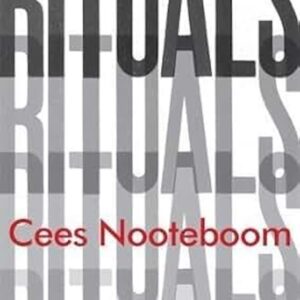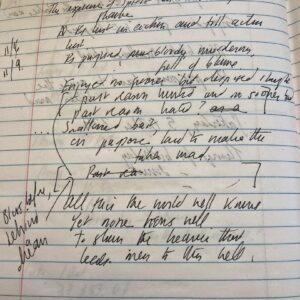It’s the middle of January now, but my Christmas tree skirt is still draped over the keyboard of the piano in our living room.
The art form of the skirt is a South American handcraft called an arpillera—a desert landscape of deep blue satin, thickly embroidered with dimensional stars and an appliqued Mary, Joseph, and baby Jesus. Its fascination for me is not merely its artistry, but a lesson that I don’t want to forget.
Flash back to an afternoon in 1986, when I was seventeen. There was an exhibit of Chilean arpilleras that had arrived at the Addison, the art museum on my boarding school’s campus. At the time, because I was interested in housewifery and the “female arts”—as opposed to the two endless student obsessions with law and investment banking—I went there for the opening.
It ended up being led by an intrepid female faculty member, a teacher who’d gone to Radcliffe and who had taught at the academy’s former sister school in the years before coeducation in the early seventies. She was the last person I’d ever imagine to cover anything involving the domestic arts.
It turned out that I was right. Her main focus was on how these particular arpilleras were designed to protest the military dictatorship of Augusto Pinochet.
That was where she lost me. Back in those days, I was primed to be against anything that involved “leftist protesters.”
But I was wrong, and Susan Lloyd, for that was her name, was right.
As the online catalogue for the 2019-2020 “Arte, Mujer, y Memoria” exhibit of arpilleras at the Museum of Latin American Art in Los Angeles notes, “Hundreds of thousands of people were persecuted, tortured, and imprisoned and over 3000 were murdered under General Augusto Pinochet.”
Now, I was an idiot and seventeen, but the problem was that the guiding concepts about Truth I’d carried in my head forestalled any ability to think with nuance about the realities in front of me: Cold War anti-communism, my own impulses toward order and authority, my relative contempt for the limousine leftists in my midst. Because said Wrong Message was being borne by a Wrong Person, I could not even hear it.
This lesson, I think, holds a charge for all of us thinking about literature on the lip of this new year. There’s been much discussion of late with respect to the political divide in the United States—the tendency to dehumanize the opposition on the basis of ideology. (Hence, the recent results of public opinion surveys that most Americans would approve of their child marrying someone of a different religion or race, but NOT political party.)
Even at the lower, less urgent frequencies, much contemporary literature seems to use ideological or cultural “shorthand” to telegraph meaning and assign narrative intention. That’s the big complaint of the recent movie American Fiction, based on the 2001 novel Erasure by Percival Everett, which explores the gap between the literature an affluent African-American writer wants to write, and the stereotypical “Black” themes of which he’s contemptuous. (I haven’t seen it yet, but it’s top of the list.)
One recent example of this phenomenon in action is the wildly successful novel 2022 Lessons in Chemistry. It’s the first published novel by a writer in her sixties, Bonnie Garmus, who had toiled on her writing for decades before striking a very big publishing chord with this one. (There’s even a limited-edition streaming series.) I have to say that, on balance, I enjoyed reading the book, which we took on as part of a virtual book club my sisters started during the pandemic. The book concerns the ways that a renegade female PhD chemist (and single mom, whose prize-winning unmarried partner has died) takes on the anti-female and sexist assumptions of the 1950s-60s professional and scientific worlds–an age, when a number of published reviews have reminded us, unmarried women could not even qualify for a credit card.
It’s an instance of the often-maligned “women’s novel,” derided in some quarters as “chick lit,” though I would be the first person to defend that genre’s seriousness against charges of anti-intellectualism. (Naomi Ragen, anyone?) A lot of the book’s popularity apparently has derived from that feeling of identification that many women have with the sexist obstacles that the female’s protagonists have to overcome–both women who remember these injustices, and those who’ve heard about them from their mothers and grandmothers, and are outraged on their behalf.
Now, I have my own sympathy, and my own outrage. In this case, though, the machinery of the novel’s capital-T themes—Mysogyny! Small-Minded Parochialism! The Stupidity of Religious Troglodytes! Intrepid Female Courage!-—completely overwhelmed the machinations of any otherwise zany, implausible plot. The book was fun and fine—it really was—but in the end, it was merely a spoon that struck the expected notes from a set of glasses filled with different levels of water. And part of the enjoyment was seeing those notes delivered, in the order I expected them.
It was an instance of “confirming my priors,” in other words, something I was primed already to believe–just as I was primed to plug my ears at Sue Lloyd’s litany of human rights abuses.
And women’s book or not (there’s a New York Times article about how the different cover designs in different countries have contributed to the book’s perception), this was no mass market paperback, spinning on a wire rack at the grocery store, this book came armed with the full faith and credit of mainstream publishing.
After a while, I started to groan a bit at the book’s predigested ideological bits, and the narrative left me a little bit nauseated. I began to wonder why any character in the book acted the way she or he did, and suddenly all the book’s presumptions and explanations began to seem facile.
Would there be an effort to get at the motivation of any of the novel’s villains? (All those sexist scientists!)
More and more, I think, it’s this tyranny of concepts—the predetermination, pre-editing, and pre-thinking—that seem to plague our literature. Instead of opening the trap door to endless perspectives, endless transfiguration, this book, along with so many, seemed to end where it started.
Are we willing to suspend what we think we know? And how diverse, really, is the quality of our reading?
Caroline Langston was a regular contributor to Image’s Good Letters blog, and is writing a memoir about the U.S. cultural divide. She has contributed to Sojourners’ God’s Politics blog, and aired several commentaries on NPR’s All Things Considered, in addition to writing book reviews for Image, Books and Culture, and other outlets. She is a native of Yazoo City, Mississippi, and a convert to the Eastern Orthodox Church. She lives outside Washington, D.C., with her husband and two children.





